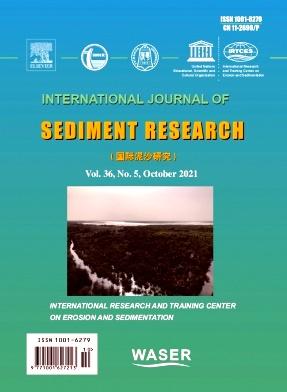Particle size and settling velocity of bed and suspended sediments for mud-sand beds
IF 3.5
2区 环境科学与生态学
Q2 ENVIRONMENTAL SCIENCES
引用次数: 0
Abstract
The particle size and the settling velocity of sediments are key parameters in sediment transport studies. However, it remains surprisingly difficult to determine particle size and settling velocity distribution of fine-grained sediments (mud-sand). A large range of methodologies exist to measure either the particle size distribution or to measure the settling velocity. An important influential parameter is the shape of fine-grained sediments, with clay minerals being shaped as plates rather than as spheres. Furthermore, the settling velocity of fine particles is influenced by turbulent shear and flocculation processes. Sometimes, the sediment samples are pre-treated (destroying inter-particle bonds) to measure the primary particle sizes involved while in other cases samples are not pre-treated in order to represent the effect of flocs. As a result, a large uncertainty exists in the way particle size and settling velocity should be measured. A range of methodologies (sedimentation, video camera, and laser-diffraction) to measure the settling velocity and particle size distribution in the field and in the laboratory is used and compared. The labour-intensive sedimentation methods measure a particle size distribution which can be used for sedimentation studies. The particle size distribution measured by the most commonly applied laser diffraction method is representative of the plate diameter of the clay particles, but the corresponding settling velocity is not correct. This difference can be explained by the shape of the clay particles through a derivation of the settling velocity of non-spherical particles resulting in a simple relationship to convert the particle size measured by laser diffraction to a representative particle size to be used in sedimentation studies. A comparison of the settling velocity measured by an in situ settling method and by a video camera method shows good agreement for high concentrations (> 2000 mg/L) but deviating results for low concentrations (< 500 mg/L).
泥沙床和悬浮沉积物的粒径和沉降速度
泥沙的粒径和沉降速度是泥沙输运研究中的关键参数。然而,确定细粒沉积物(泥砂)的粒度和沉降速度分布仍然非常困难。测量颗粒大小分布或沉降速度的方法有很多种。一个重要的影响参数是细粒度沉积物的形状,粘土矿物的形状是板状而不是球形。此外,细颗粒的沉降速度受湍流剪切和絮凝过程的影响。有时,沉淀物样品被预处理(破坏颗粒间键)以测量所涉及的主要颗粒大小,而在其他情况下,样品不被预处理以表示絮凝体的影响。因此,粒径和沉降速度的测量方法存在很大的不确定性。在现场和实验室中使用和比较了一系列测量沉降速度和粒度分布的方法(沉降、摄像机和激光衍射)。劳动密集型沉降法测量可用于沉降研究的粒度分布。目前应用最广泛的激光衍射法测得的黏土颗粒粒径分布能够代表黏土颗粒的板径,但相应的沉降速度并不正确。这种差异可以用粘土颗粒的形状来解释,通过推导非球形颗粒的沉降速度,得出一个简单的关系,将激光衍射测量的粒度转换为沉积研究中使用的代表性粒度。用原位沉降法和摄像机法测量的沉降速度的比较表明,高浓度(>;2000 mg/L),但低浓度(<;500 mg / L)。
本文章由计算机程序翻译,如有差异,请以英文原文为准。
求助全文
约1分钟内获得全文
求助全文
来源期刊
CiteScore
6.90
自引率
5.60%
发文量
88
审稿时长
74 days
期刊介绍:
International Journal of Sediment Research, the Official Journal of The International Research and Training Center on Erosion and Sedimentation and The World Association for Sedimentation and Erosion Research, publishes scientific and technical papers on all aspects of erosion and sedimentation interpreted in its widest sense.
The subject matter is to include not only the mechanics of sediment transport and fluvial processes, but also what is related to geography, geomorphology, soil erosion, watershed management, sedimentology, environmental and ecological impacts of sedimentation, social and economical effects of sedimentation and its assessment, etc. Special attention is paid to engineering problems related to sedimentation and erosion.

 求助内容:
求助内容: 应助结果提醒方式:
应助结果提醒方式:


